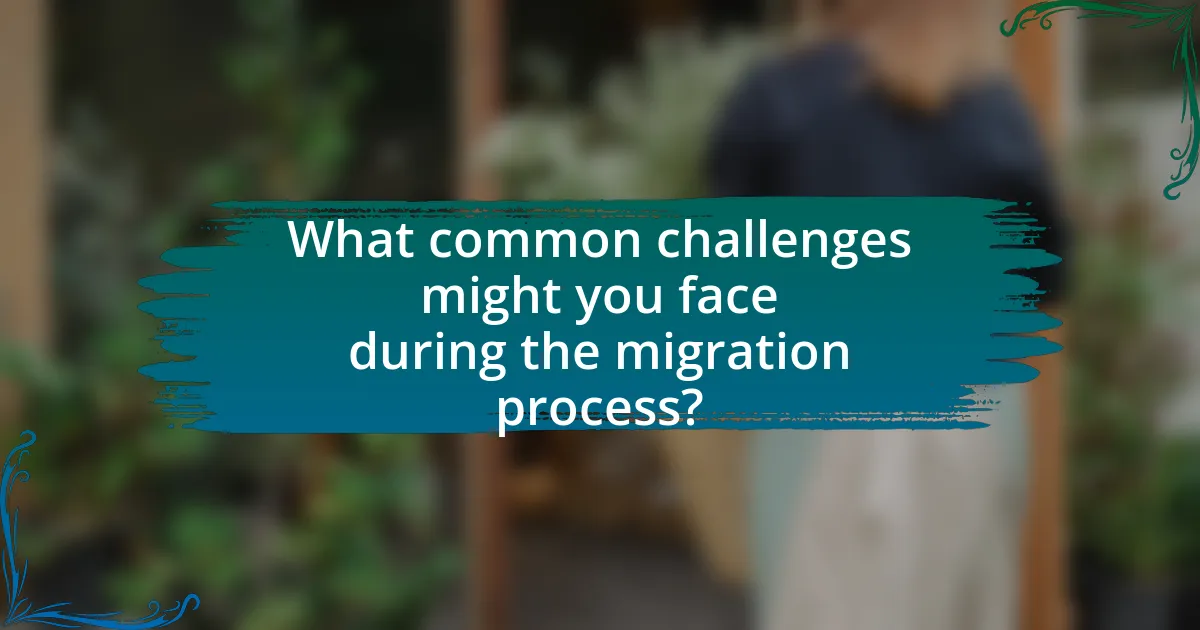The article provides a comprehensive guide on migrating from free to paid hosting, detailing the essential steps involved in the process. Key topics include selecting a suitable paid hosting provider, backing up website data, transferring files, and updating DNS settings to ensure a smooth transition. It also highlights the advantages of paid hosting, such as improved performance, security features, and dedicated customer support. Additionally, the article addresses common challenges faced during migration and offers best practices for optimizing the new hosting environment and maintaining website performance post-migration.

What is the process of migrating from free to paid hosting?
The process of migrating from free to paid hosting involves several key steps. First, select a paid hosting provider that meets your needs, considering factors such as storage, bandwidth, and support. Next, sign up for the chosen hosting plan and set up your account. After that, back up your website data from the free hosting platform, ensuring you save all files, databases, and configurations. Then, upload the backed-up data to the new paid hosting server using FTP or a control panel. Finally, update your domain’s DNS settings to point to the new hosting provider, which may take up to 48 hours to propagate. This structured approach ensures a smooth transition from free to paid hosting.
Why should you consider migrating to paid hosting?
Migrating to paid hosting is advisable due to enhanced performance, security, and customer support. Paid hosting services typically offer faster loading times and greater uptime reliability compared to free hosting, which can lead to improved user experience and better search engine rankings. Additionally, paid hosting often includes advanced security features, such as SSL certificates and regular backups, which protect your website from cyber threats. Furthermore, paid hosting providers usually offer dedicated customer support, ensuring that any technical issues can be resolved quickly and efficiently. These factors collectively contribute to a more professional and reliable online presence.
What advantages does paid hosting offer over free hosting?
Paid hosting offers greater reliability and performance compared to free hosting. Users of paid hosting benefit from dedicated resources, which ensure faster loading times and better uptime, typically exceeding 99.9%. Additionally, paid hosting services often include enhanced security features, such as SSL certificates and regular backups, which are crucial for protecting sensitive data. According to a study by HostingAdvice, 70% of businesses reported improved website performance after switching from free to paid hosting, highlighting the tangible benefits of investing in a paid service.
How can paid hosting improve your website’s performance?
Paid hosting can significantly improve your website’s performance by providing faster loading times, increased uptime, and better security features. Faster loading times are achieved through dedicated resources and optimized server configurations, which can reduce page load times by up to 50% compared to free hosting services. Increased uptime is another benefit, as paid hosting typically offers service level agreements (SLAs) that guarantee 99.9% uptime, minimizing the risk of your website being inaccessible. Additionally, paid hosting often includes advanced security measures, such as SSL certificates and regular backups, which protect your site from cyber threats and data loss. These enhancements collectively contribute to a better user experience and improved search engine rankings.
What are the key steps involved in the migration process?
The key steps involved in the migration process from free to paid hosting include planning, backing up data, selecting a new hosting provider, transferring files, updating DNS settings, and testing the new setup.
Planning involves assessing the current website and determining the requirements for the new hosting environment. Backing up data ensures that all website files, databases, and configurations are securely saved before migration. Selecting a new hosting provider requires evaluating options based on performance, support, and pricing. Transferring files involves moving website content to the new server, often using FTP or a migration tool. Updating DNS settings is necessary to point the domain to the new hosting provider, which may take time to propagate. Finally, testing the new setup confirms that the website functions correctly on the new hosting platform.
How do you choose the right paid hosting provider?
To choose the right paid hosting provider, evaluate key factors such as reliability, performance, customer support, and pricing. Reliability is crucial; look for providers with a proven uptime record of at least 99.9%, as this ensures your website remains accessible. Performance metrics, including server speed and load times, should also be assessed, with many providers offering benchmarks or speed tests. Customer support is vital; opt for a provider that offers 24/7 support through multiple channels, such as live chat, email, and phone. Finally, compare pricing plans, ensuring they align with your budget while providing the necessary features, such as bandwidth, storage, and scalability options. Researching user reviews and expert recommendations can further validate your choice, as they provide insights into real-world experiences with the hosting provider.
What factors should you consider when selecting a hosting plan?
When selecting a hosting plan, consider factors such as performance, scalability, security, customer support, and pricing. Performance is crucial as it affects website speed and uptime; for instance, a study by Google indicates that a one-second delay in loading time can reduce conversions by 20%. Scalability ensures that your hosting can grow with your website, accommodating increased traffic without downtime. Security features, including SSL certificates and regular backups, protect your data and enhance user trust. Customer support availability, ideally 24/7, is essential for resolving issues promptly. Lastly, pricing should align with your budget while providing the necessary features, as a plan that is too cheap may lack essential services.

How do you prepare for the migration from free to paid hosting?
To prepare for the migration from free to paid hosting, first, assess your current website’s requirements, including storage, bandwidth, and specific features needed for optimal performance. Next, choose a suitable paid hosting plan that meets these requirements, ensuring it offers scalability and support. Additionally, back up all website data, including files and databases, to prevent data loss during the transition. Finally, plan the migration process by creating a timeline and checklist to ensure all steps are followed systematically, minimizing downtime and disruption.
What pre-migration tasks should you complete?
Before migrating from free to paid hosting, you should complete several pre-migration tasks. First, back up all website files and databases to ensure data integrity during the transition. This includes exporting databases and downloading all website content, such as images, themes, and plugins. Next, review the current website for any dependencies or configurations that may need to be replicated on the new hosting environment. Additionally, update DNS settings to point to the new hosting provider once the migration is complete. Finally, test the new hosting environment with a staging site to ensure everything functions correctly before making the final switch. These tasks are essential to minimize downtime and data loss during the migration process.
How do you back up your website data before migration?
To back up your website data before migration, use a reliable backup plugin or tool that can create a complete copy of your website files and database. For instance, plugins like UpdraftPlus or BackupBuddy can automate the backup process, ensuring all content, themes, and settings are securely stored. Additionally, manually backing up involves accessing your website’s file manager or FTP client to download all files, and exporting the database through tools like phpMyAdmin. This method ensures that you have a comprehensive backup, which is crucial for restoring your site if any issues arise during migration.
What information do you need from your current hosting provider?
To migrate from free to paid hosting, you need specific information from your current hosting provider, including your account details, data storage limits, bandwidth usage, and any existing backups. This information is crucial for ensuring a smooth transition to a new hosting environment. For instance, knowing your data storage limits helps you select a paid plan that accommodates your website’s needs, while understanding bandwidth usage allows you to avoid potential downtime during the migration process. Additionally, having access to backups ensures that you can restore your website if any issues arise during the migration.
How can you ensure a smooth transition during migration?
To ensure a smooth transition during migration from free to paid hosting, it is essential to create a detailed migration plan that includes a timeline, a checklist of tasks, and a backup of all data. This structured approach minimizes the risk of data loss and downtime. According to a study by the Hosting and Domain Industry Association, 70% of successful migrations are attributed to thorough planning and preparation, highlighting the importance of these steps. Additionally, testing the new environment before fully switching over can identify potential issues, further ensuring a seamless transition.
What steps should you take to minimize downtime during migration?
To minimize downtime during migration, implement a well-planned strategy that includes pre-migration testing, data backup, and a phased transition. Pre-migration testing ensures that the new hosting environment is configured correctly and can handle the expected traffic, reducing the risk of issues during the actual migration. Data backup protects against data loss, allowing for recovery if problems arise. A phased transition, where you migrate parts of your site incrementally, allows for monitoring and troubleshooting without affecting the entire site at once. These steps are supported by industry best practices, which emphasize the importance of preparation and gradual implementation to ensure a smooth migration process.
How do you test your website after migration to ensure everything works?
To test your website after migration and ensure everything works, conduct a comprehensive review that includes checking functionality, performance, and compatibility. Start by verifying that all links, forms, and interactive elements function correctly, as broken links can negatively impact user experience and SEO. Next, assess the website’s loading speed using tools like Google PageSpeed Insights, as performance issues can arise during migration. Additionally, test the website across different browsers and devices to confirm compatibility, ensuring that it displays correctly for all users. Finally, monitor server response times and error logs to identify any underlying issues that may not be immediately visible. This systematic approach helps ensure a smooth transition and optimal website performance post-migration.

What common challenges might you face during the migration process?
Common challenges during the migration process include data loss, downtime, and compatibility issues. Data loss can occur if backups are not properly managed, leading to the potential loss of critical information. Downtime may happen if the migration is not planned effectively, disrupting service availability for users. Compatibility issues arise when the new hosting environment does not support existing applications or configurations, which can hinder functionality. These challenges are frequently reported in migration case studies, highlighting the importance of thorough planning and testing to mitigate risks.
What issues can arise when migrating from free to paid hosting?
When migrating from free to paid hosting, issues such as data loss, downtime, and compatibility problems can arise. Data loss may occur if backups are not properly managed during the transition, leading to the potential loss of website content. Downtime can happen if the migration process is not executed smoothly, resulting in users being unable to access the site temporarily. Compatibility problems may arise if the new hosting environment differs significantly from the previous one, affecting website functionality or performance. These issues highlight the importance of careful planning and execution during the migration process to ensure a seamless transition.
How do you troubleshoot common migration problems?
To troubleshoot common migration problems, first identify the specific issue, such as data loss, downtime, or configuration errors. Next, verify that all files and databases have been correctly transferred and check for any missing or corrupted files. Additionally, ensure that DNS settings are properly configured to point to the new server. If issues persist, consult server logs for error messages that can provide insight into the problem. According to a study by the HostingAdvice team, 70% of migration issues stem from improper DNS configurations, highlighting the importance of this step in the troubleshooting process.
What should you do if your website experiences downtime after migration?
If your website experiences downtime after migration, first check the DNS settings to ensure they are correctly pointing to the new server. Misconfigured DNS settings are a common cause of downtime, as they can prevent users from accessing the site. Next, verify that the new hosting environment is properly configured, including server settings, database connections, and file permissions. According to a study by the website monitoring service Pingdom, 90% of website downtime is attributed to server misconfigurations or DNS issues. If these checks do not resolve the issue, consult your hosting provider for assistance, as they can provide insights into server status and potential outages.
What are the best practices for a successful migration?
The best practices for a successful migration from free to paid hosting include thorough planning, data backup, and testing. First, planning involves assessing the current website structure and identifying necessary resources on the new hosting platform. Data backup is crucial; it ensures that all website files, databases, and configurations are securely saved before migration, minimizing the risk of data loss. Testing the new environment before going live is essential to confirm that all functionalities work correctly and that the website performs as expected. Following these practices significantly reduces downtime and enhances the overall migration experience.
How can you optimize your website for the new hosting environment?
To optimize your website for the new hosting environment, ensure that you configure server settings according to the specifications of the new host. This includes adjusting PHP versions, enabling caching mechanisms, and optimizing database connections. Additionally, you should implement a Content Delivery Network (CDN) to enhance loading speeds and reduce latency. According to a study by Akamai, websites that utilize CDNs can experience up to a 50% improvement in load times. Furthermore, regularly monitor performance metrics using tools like Google PageSpeed Insights to identify areas for further optimization.
What ongoing maintenance should you perform after migration?
After migration, ongoing maintenance should include regular backups, performance monitoring, security updates, and content management. Regular backups ensure data integrity and recovery in case of failures, while performance monitoring helps identify and resolve issues that may affect user experience. Security updates are crucial to protect against vulnerabilities, and content management ensures that the website remains relevant and engaging. These practices are essential for maintaining a stable and secure hosting environment, as they directly contribute to the website’s reliability and user satisfaction.
What tips can help you make the most of your paid hosting experience?
To make the most of your paid hosting experience, choose a hosting plan that aligns with your website’s needs, ensuring it offers sufficient bandwidth, storage, and support. Selecting a plan that matches your traffic expectations and resource requirements is crucial; for instance, a website expecting high traffic should opt for a plan with scalable resources. Additionally, utilize the customer support services provided by your hosting provider, as they can assist with technical issues and optimize your site’s performance. Research shows that 70% of users value responsive customer support, which can significantly enhance your hosting experience. Regularly back up your website data to prevent loss, as 30% of websites experience data loss due to various factors. Finally, take advantage of any included features, such as website builders or security tools, to enhance your site’s functionality and security.


